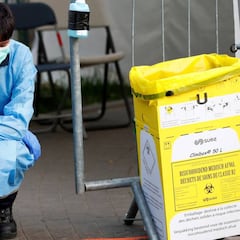Coronavirus updates UK: cases, deaths, real-time map - 17 April
Updates on the total number of confirmed Covid-19 cases, deaths and discharged patients, both in the United Kingdom and throughout the world on Friday 17 April.

Confirmed UK coronavirus cases
As of 21:00 BST (22:00 CEST) on Friday 17 April, there had been 109,769 confirmed cases of coronavirus in the UK, with 14,607 deaths in total.
Worldwide real-time coronavirus map
Click here if the map doesn't automatically appear. (Map created and hosted by Johns Hopkins University Whiting School of Engineering, our thanks to them)
Worldwide coronavirus cases
According to the latest figures published by Johns Hopkins University, 2,214,861 cases have been detected worldwide, with 151,006 deaths and 565,864 people now recovered.
See also:
Netflix overtakes Disney as streaming services surge
Premier League clubs to meet to discuss football's 'millennium bug'
Live coverage of the coronavirus pandemic
Related stories
You can follow the latest developments in the Covid-19 crisis with our daily live blog.
The complete lowdown on Covid-19
Check out our in-depth guide to the coronavirus pandemic.
In January, 2009 a novel strain of the H1N1 virus (labelled H1N1-pdm09 which became more popularly known as Swine Flu) emerged, creating a pandemic that lasted 19 months and killing as many as half a million people worldwide, according to estimates.
Very much like the coronavirus situation, there was no immunity or vaccine at the start of the outbreak, which caused widespread panic.
The first the case of the H1N1 was detected in Mexico, after which the virus went on to infect 24 percent of the world’s population. While there is no definite figure, the Center for Disease Control and Protection estimated that 151,700-575,400 people worldwide died from H1N1 virus infection during the first year the virus circulated. In the United States alone, the CDC estimated there were 60.8 million cases, with 12,469 deaths. Unlike the coronavirus, the disease was more deadly for younger demographics. It was estimated that 80 percent of H1N1 victims worldwide were younger than 65 years of age.
Thankfully, after a vaccine was released in December, 2009, the WHO was finally able to announce the end of the pandemic ten months later in August 2010. From that date, health experts had warned that a new global pandemic would inevitably emerge in the not-so-distant future. And so their predictions have finally become a reality a decade later as the world struggles to deal with the unprecedented social, health and economic fallout of the coronavirus pandemic.
How does H1N1 compare to Covid-19?
So how do the numbers compare to date, bearing in mind of course we are still a long way announcing an end to the coronavirus pandemic.
At the time of writing, there were 2,165,500 confirmed cases of coronavirus, with 145,593 deaths. At the end of the 2009/10 Swine Flu pandemic, confirmed cases and deaths from H1N1 stood at 1.6 million and 18,448, respectively. However, as aforementioned, the estimations are much higher, suggesting that the current coronavirus figures could also be a long way off the reality.
According to recent comments by the Director General of the World Health, Tedros Adhanom Ghebreyesus, the coronavirus is ten times deadlier than the swine flu outbreak a decade ago.
“We know that Covid-19 spreads fast and we know that it is deadly – ten times deadlier than the 2009 flu pandemic. We know that the virus can spread more easily in crowded environments like nursing homes. We know that early case finding, testing, isolating, caring for every case, and tracing every contact is essential for stopping transmission.
“We know that in some countries cases are doubling every three to four days. However while Covid-19 accelerates very fast it decelerates much more slowly.
“In other words the way down is much slower than the way up. That means control measures must be lifted slowly and with control”.
And while the focus remains on curbing the spread of coronavirus over the coming months through social distancing and other control measures, the H1N1 virus that emerged in 2009 continues to circulate as a seasonal flu virus, and cause illness, hospitalization, and deaths worldwide every year.

